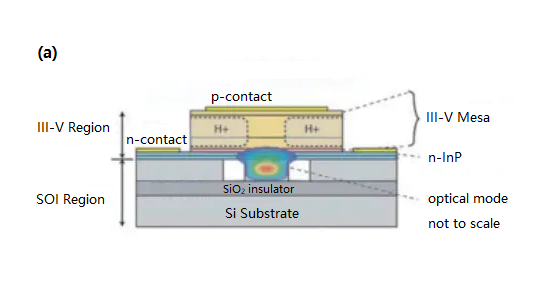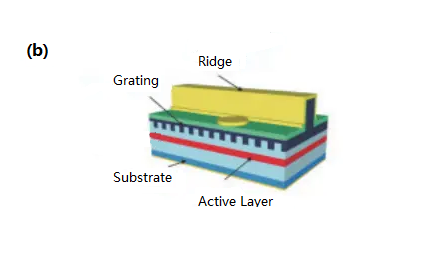Core Device of Silicon Photonic Chip - Silicon-based Laser
2024-03-29
Silicon-based lasers refer to lasers integrated on optical chips with silicon as the substrate. Commonly used silicon-based lasers are mainly divided according to structure: Vertical-Cavity Surface-Emitting Laser (VCSEL), Fabry-Perot (FP), Distributed Bragg Reflector (DBR), Distributed Feedback (DFB) and Electro absorption modulated distributed feedback laser (EML).
VCSEL is the lowest cost, but has a large light emitting angle and a multi-mode output light field, which limits its use to short-distance scenarios of 500 m. A Bragg grating is built into the FP laser to filter the output light more accurately to form a DBR or DFB laser. After filtering, a single longitudinal mode output is formed, which can increase the transmission distance from 20 km to more than 40 km, and is used in transmission networks, wireless base stations, and internal interconnection of data centers. DFB and DBR lasers have similar characteristics in narrow linewidth and high side mode suppression rate, but DFB laser has a larger mode-hopping-free tuning range, more consistent tuning coefficients, and better uniformity of spectral characteristics; DBR's grating is not distributed In the entire active area, larger current input can be achieved, so the output power will be larger than that of DFB, but it will introduce larger power, current noise, and cause power jitter. All three lasers use direct modulation, which loads an electrical signal onto a light wave by changing the laser voltage.
EML consists of a laser and an external modulator, such as an electroabsorption modulator (EAM): by controlling the voltage of the electroabsorption chip, an electrical signal is loaded onto the light wave continuously output by the laser. This way of loading signals is called external modulation technology. This method greatly improves the life, stability, and modulation efficiency of the laser, reduces chirp, and is more suitable for long-distance transmission, but the cost is higher. It is mainly used in high-speed long-distance backbone networks, metropolitan area networks, and data center interconnections. For ultra-long distance data transmission, it is necessary to use dense wavelength division multiplexing (DWDM) technology, high-order signal modulation formats and other methods to expand the capacity. This requires the light source to have multiple wavelengths, small wavelength intervals, narrow line widths, etc. characteristics, so the optimization of silicon-based integrated tunable narrow linewidth lasers is also very important.
At present, silicon-based lasers are mainly made of III-V semiconductor materials, including gallium antimonide (GaSb), gallium arsenide (GaAs), indium phosphide (InP), zinc sulfide (ZnS), etc. Therefore, how to realize the coupling of III-V lasers and silicon photonic chips is a key issue. The mainstream process solutions include on-chip flip-chip soldering integration, on-chip heterogeneous bonding integration and on-chip direct epitaxial growth integration. On-chip flip-chip welding flip-chips the produced laser onto a silicon photonic chip that already contains a silicon photonic device. This process is low-cost and relatively mature, but it requires high placement accuracy, high time costs, and low integration. On-chip heterogeneous bonding integration is divided into direct bonding and adhesive bonding according to whether adhesive is used. The unstructured III-V materials are directly "bonded" on the silicon photonic chip that has been processed with silicon photonic devices. The III-V material block is then processed into a laser, and the light emitted by the laser can be efficiently coupled into the silicon photonic circuit through evanescent wave coupling.

Figure (a) is the end face of the III-V/Si bonded laser.

Figure (b) is the structure of the DFB laser.







